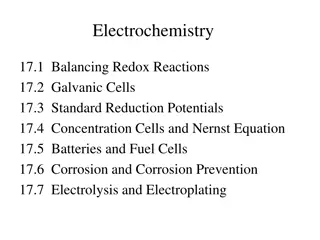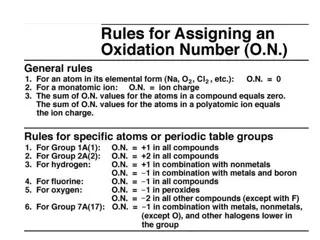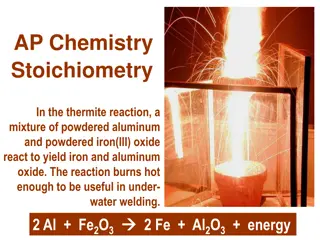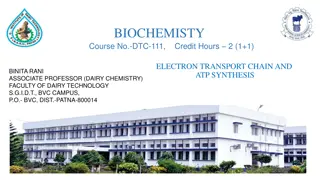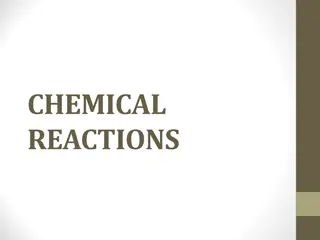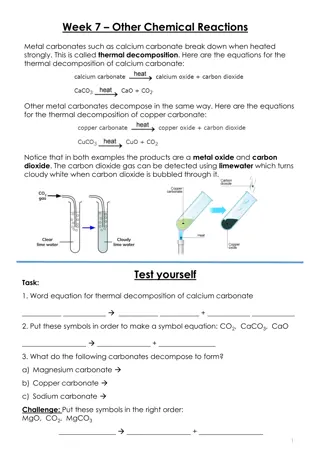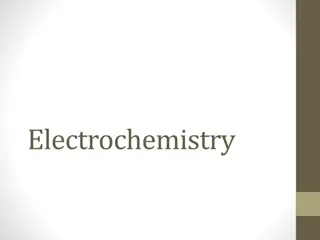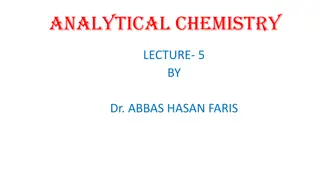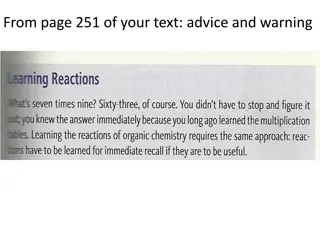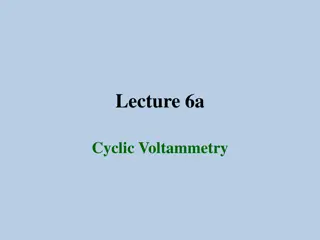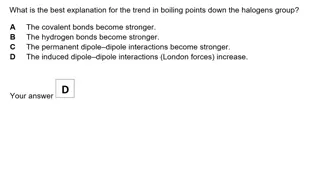Chemical Analysis and Redox Reactions in Chemistry
Iron(II) ethanoate concentration determination using redox titration with cerium(IV) sulfate, balanced redox equations for manganate(VII) ion oxidizing iron(II) ion, and calculations of iron percentage in samples using titration with potassium manganate(VII). Molarities and concentrations are calculated based on titration volumes, masses, and chemical equations.
Download Presentation

Please find below an Image/Link to download the presentation.
The content on the website is provided AS IS for your information and personal use only. It may not be sold, licensed, or shared on other websites without obtaining consent from the author. Download presentation by click this link. If you encounter any issues during the download, it is possible that the publisher has removed the file from their server.
E N D
Presentation Transcript
The concentration of an iron(II) ethanoate solution can be determined by a redox titration with cerium(IV) sulfate. A few drops of an indicator are added. The solution turns purple at the end point. The equation for the reaction between Ce4+ and Fe2+ is given below. Ce4+(aq) + Fe2+(aq) Ce3+(aq) + Fe3+(aq) (i) Give the formula of cerium(IV) sulfate. .............................................................................................................. [1] (ii) A student found that a 25.0 cm3 sample of an iron(II) ethanoate solution required a titre of 18.5 cm3 of 0.100 mol dm 3 cerium(IV) sulfate solution. Calculate the concentration of Fe2+ in the iron(II) ethanoate solution. 1. moles of Ce4+ in titre = 0.100 x (18.5/1000) (= 0.00185) 2. moles of Fe2+ in 25.0 cm3 = 0.00185 Ce(SO4)2 moles of Fe2+ in 1000 cm3 = 0.00185 x 1000 / 25.0 = 0.0740
MnO4(aq)+ 8H+(aq)+ 5e Fe3+(aq)+ e Mn2+(aq)+ 4H2O(l) Fe2+(aq) Using above, construct a fully balanced redox ionic equation for the manganate(VII) ion oxidising the iron(II) ion Flip the iron equation around so you start with Fe2+ and x5 to balance electrons 5 Fe3+(aq)+ 5 e 5 Fe2+(aq) MnO4 (aq)+ 8H+(aq)+ 5Fe2+ + 5e- Mn2+(aq)+ 4H2O(l)5Fe3+(aq) 5e- MnO4 (aq)+ 8H+(aq)+ 5Fe2+ Mn2+(aq)+ 4H2O(l)5Fe3+(aq)
MnO4(aq)+ 8H+(aq)+ 5Fe2+ Mn2+(aq)+ 4H2O(l)5Fe3+(aq) Calculate the percentage of iron in a sample of steel wire if 1.51 g of the wire was dissolved in excess of dilute sulphuric acid and the solution made up to 250 cm3in a volumetric flask. A 25.0 cm3 aliquot of this solution was pipetted into a conical flask and needed 25.45 cm3 of 0.0200 mol dm 3 KMnO4 for complete oxidation. mol MnO4 = 0.0200 x 25.45 / 1000 = 0.000509 mol Fe = 5 x 0.000509 = 0.00255, mass Fe = 0.00255 x 55.8 = 0.142 g total Fe in wire = 0.142 x 10 = 1.42 g (only1/10th of the made up solution used in titration) Hence % Fe = 1.42 x 100 / 1.51 = 94.0 %
MnO4(aq)+ 8H+(aq)+ 5Fe2+ 8.25g of an iron(II) salt was dissolved in 250 cm3of pure water. 25.0 cm3aliquots were pipetted from this stock solution and titrated with 0.0200 moldm 3potassium manganate(VII) solution. The titration values obtained were 24.20 cm3, 23.95 cm3, 23.80 cm3and 23.85 cm3. Calculate the % iron in the salt. Mn2+(aq)+ 4H2O(l)5Fe3+(aq) Av titre = 23.83 cm3 (ignore 24.10 cm3 not concordant mol MnO4 = 0.0200 x 23.83/1000 = 4.766 x 10 4 From the balanced redox equation, 1 MnO4 oxidises 5 mol Fe2+ mol Fe2+= 5 x 4.766 x 10 4= 2.383 x 10 3 mol = mass/atomic mass, so mass = mol x atomic mass mass Fe = 2.383 x 10 3x 55.8 = 0.133 g Total mass of iron = 10 x 0.133 = 1.33 g (scaling for 250/25) % iron in the original salt = 1.33 x 100 / 8.25 = 16.1% (1dp, 3sf)
It takes 38.29 cm3 of a permanganate solution to titrate 0.2587 g of NaC2O4 (M = 133.9). What is the molarity of the permanganate? 5C2O42- + 2MnO4- + 16H+ 2Mn2+ + 10CO2 + 8H2O
A 0.4857 g iron ore sample was dissolved in concentrated acid and reduced to Fe2+ using SnCl2. 41.21 cm3 of 0.0196 mol dm-3 MnO4- was required to titrate the sample. Calculate the %Fe in the ore. MnO4- + 8H+ + 5Fe2+ Mn2+ + 5Fe3+ + 4H2O



